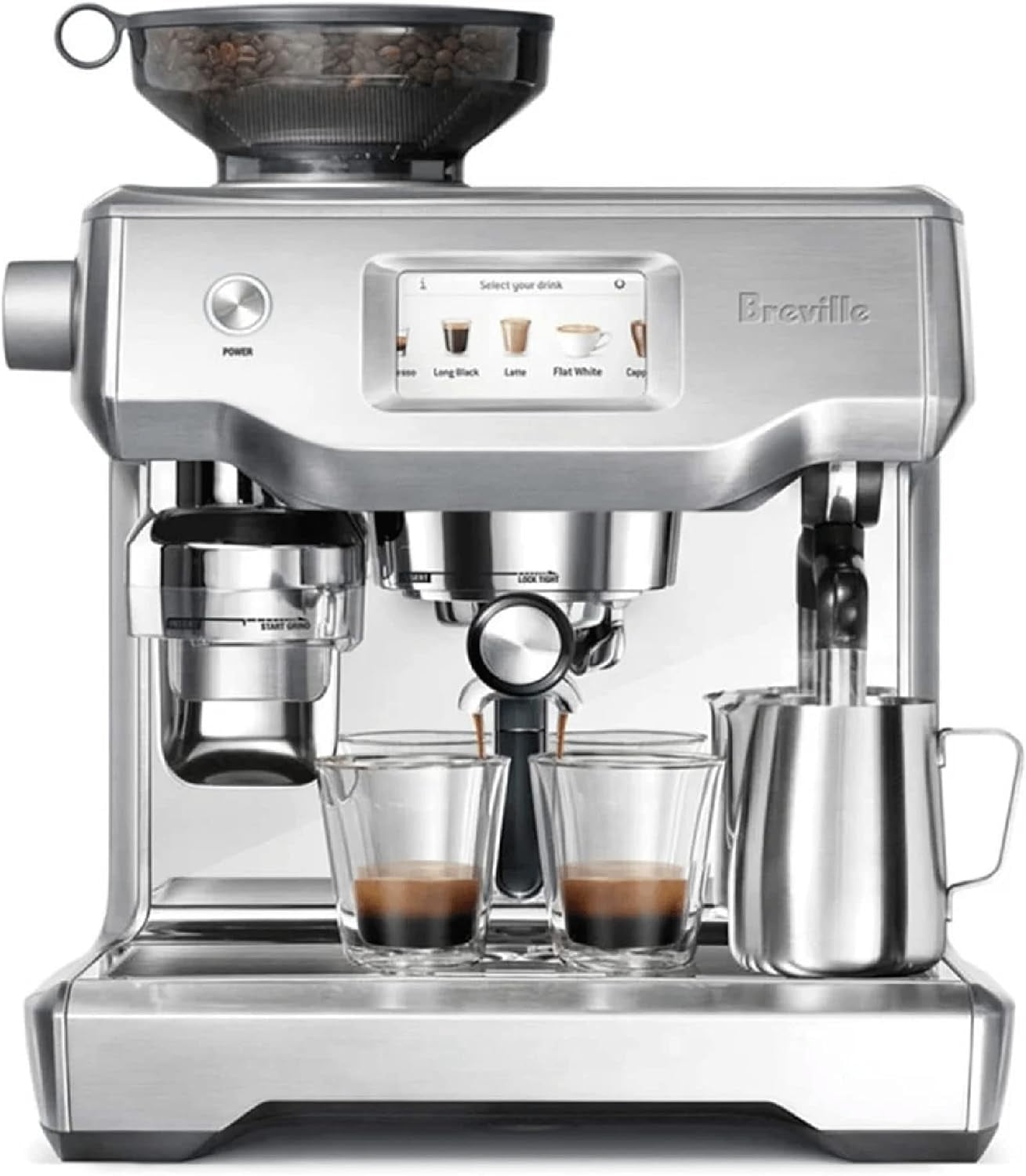#1: Breville Oracle
- Dual boiler system for simultaneous brewing and steaming
- Automatic grinding, dosing, and tamping
- Precise temperature control for consistent espresso
#2: Breville Oracle Touch

- Touchscreen for easy, customizable drink selection.
- Automated milk texturing for perfect froth.
- Fully automatic espresso process with user-friendly interface.
As a self-proclaimed coffee aficionado, I’ve always been on the lookout for the ultimate espresso machine. I’m someone who enjoys the ritual of brewing coffee almost as much as the drink itself. Over the years, I’ve tried many machines, but none have intrigued me more than the Breville Oracle and Oracle Touch. These two models are known for their premium features and ability to deliver café-quality coffee at home. After spending considerable time with both, I’ve developed a strong preference for one of them—and I’d love to share my insights.


First Impressions: What Sets These Machines Apart
From the moment I unboxed these machines, I was struck by their solid stainless-steel design and the sheer thoughtfulness of their construction. The Breville Oracle feels like a traditionalist’s dream with its manual controls, while the Oracle Touch seems tailor-made for the tech-savvy coffee lover who values convenience without sacrificing quality.
One thing I immediately noticed was the effort Breville has put into ensuring both machines cater to different types of users. The Oracle Touch’s touchscreen interface is inviting and easy to navigate, making it accessible even for those new to home espresso brewing. On the other hand, the Oracle offers a more hands-on experience, which may appeal to those who enjoy having full control over every step of the process.
Brewing Coffee: Where the Magic Happens
One of the most important aspects of any espresso machine is how well it handles brewing. I started with the Oracle, experimenting with grind size, tamping pressure, and extraction time. It was a rewarding process that let me fine-tune my coffee to perfection. However, it did take a bit of trial and error to find the right settings for my preferred taste.
Switching to the Oracle Touch was a completely different experience. The machine’s preset beverage options made it incredibly easy to prepare everything from a classic espresso to a silky latte. It took only a few taps on the screen to achieve results that rivaled my local café. The automated pre-infusion and extraction process ensured consistency, which was particularly helpful when I was in a hurry but still wanted a perfect cup.
Steam Wand Performance: A Latte Lover’s Dream
One feature I was especially excited to test was the steam wand. As someone who loves crafting lattes and cappuccinos, I know how important it is to achieve the perfect milk texture. The Oracle’s manual steam wand gave me complete control, allowing me to practice my latte art skills. While this was a fun and satisfying challenge, it did require some practice to get the microfoam just right.
The Oracle Touch, however, made milk texturing effortless. Its automated steam wand adjusted the temperature and texture based on the beverage I selected. The result was a consistently silky microfoam that felt luxurious with every sip. If you’re someone who enjoys milk-based drinks but doesn’t want to spend time mastering the steam wand, the Oracle Touch is an absolute game-changer.
Customization: Catering to Every Preference
One of the standout features of the Oracle Touch is its ability to save personalized settings for up to eight different drinks. In my household, this was a game-changer. Everyone could save their preferred coffee style, from the grind size to the milk temperature. It eliminated the need to manually adjust settings each time, making mornings much smoother for all of us.
While the Oracle does offer manual adjustments, it lacks this level of programmability. This wasn’t a dealbreaker for me, but it’s worth considering if you have multiple coffee drinkers in your home with varying preferences.
Daily Use: Convenience vs. Control
Using these machines daily gave me a clear understanding of their strengths. The Oracle’s manual operation provided a rewarding experience, particularly on weekends when I had more time to indulge in the coffee-making process. It felt like I was honing a craft, which added a sense of accomplishment to each cup.
On busy weekdays, however, the Oracle Touch became my go-to. Its touchscreen interface and automated features allowed me to enjoy high-quality coffee without the extra effort. The presets ensured consistent results, and I could trust the machine to deliver the same great taste every time.
Maintenance and Cleaning: Keeping It Simple
Maintaining these machines is surprisingly straightforward, especially considering their advanced features. Both models come with automatic cleaning cycles and reminders for tasks like descaling. The Oracle Touch simplifies this further by providing step-by-step on-screen instructions, which made the process foolproof.
I appreciated how Breville designed these machines with the user in mind, ensuring that upkeep didn’t become a chore. A clean machine not only lasts longer but also ensures your coffee tastes its best, so these features were a big plus for me.
Why I Recommend the Oracle Touch
After months of using both machines, I can confidently say that the Breville Oracle Touch edges out the competition for me. While the Oracle is a fantastic machine that offers a rewarding manual experience, the Oracle Touch’s combination of convenience, consistency, and advanced features makes it a standout choice.
That said, your preference may depend on what you value most in a coffee machine. If you’re someone who enjoys the process of manually crafting your coffee and experimenting with settings, the Oracle might be the better fit. But if you’re like me and want a machine that simplifies the process while still delivering exceptional results, the Oracle Touch is hard to beat.


Final Thoughts
Choosing between the Breville Oracle and Oracle Touch ultimately comes down to your priorities and lifestyle. Both machines are exceptional in their own right, offering features that cater to different types of coffee lovers. Having personally used both, I can say that the Oracle Touch has significantly improved my daily coffee routine, making it easier and more enjoyable to savor café-quality drinks from the comfort of my home.
Investing in a high-end espresso machine is a big decision, but I believe it’s worth it for anyone who truly loves coffee. Whether you choose the Oracle or the Oracle Touch, you’re guaranteed a machine that will elevate your coffee experience and bring joy to your mornings.
Frequently Asked Questions (FAQ)
Q: What is the main difference between the Breville Oracle and Oracle Touch?
A: The primary difference lies in the user interface and level of automation. The Oracle features manual controls and a traditional interface with buttons and an LCD screen, ideal for those who enjoy customizing every step of the coffee-making process. The Oracle Touch, on the other hand, comes with a touchscreen interface, offering preset beverage options and more automated features for convenience.
Q: Which machine is better for beginners?
A: The Oracle Touch is better suited for beginners due to its intuitive touchscreen, preset options, and automated processes. It simplifies coffee making, ensuring consistent results with minimal effort, making it a great choice for those new to brewing espresso at home.
Q: Can I save my customized drink preferences?
A: Yes, but only on the Oracle Touch. It allows users to save personalized settings for up to eight drinks, including grind size, milk texture, and temperature. The Oracle does not offer this feature but allows manual customization for each brew.
Q: Does the Oracle Touch compromise on quality for automation?
A: No, the Oracle Touch maintains high-quality brewing standards while offering automation. Its dual boilers, precise temperature control, and integrated grinder ensure the coffee’s flavor and texture remain on par with professional machines.
Q: Are both machines capable of making latte art?
A: Yes, both machines are capable of producing milk suitable for latte art. The Oracle provides manual control over the steam wand, which is ideal for creating intricate designs. The Oracle Touch automates milk texturing but still delivers silky microfoam that can be used for simple latte art.
Q: How easy is it to clean and maintain these machines?
A: Both machines are easy to maintain, featuring automatic cleaning cycles and alerts for tasks like descaling. The Oracle Touch goes a step further by providing on-screen instructions for maintenance, making the process more user-friendly.
Q: Which machine is better for households with multiple coffee drinkers?
A: The Oracle Touch is better for households with multiple users due to its ability to save personalized drink settings. This feature allows each person to quickly access their preferred coffee style without adjusting the machine manually.
Q: Is the Oracle Touch worth the extra cost?
A: The Oracle Touch justifies its higher price with advanced features like the touchscreen interface, automated milk texturing, and customizable drink settings. If you value convenience and consistency, it’s a worthwhile investment.
Q: Can the Oracle match the level of control offered by professional machines?
A: Yes, the Oracle offers a high degree of manual control over grind size, tamping, and extraction, making it suitable for those who want a hands-on brewing experience similar to professional-grade machines.
Q: Are both machines suitable for espresso and milk-based drinks?
A: Absolutely. Both the Oracle and Oracle Touch excel at making espresso and milk-based beverages, such as lattes and cappuccinos, with their dual boilers and steam wands designed for optimal milk texturing.
